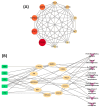Mechanistic Insights into the Antioxidant Potential of Sugarcane Vinegar Polyphenols: A Combined Approach of DPPH-UPLC-MS, Network Pharmacology and Molecular Docking
- PMID: 39517163
- PMCID: PMC11545288
- DOI: 10.3390/foods13213379
Mechanistic Insights into the Antioxidant Potential of Sugarcane Vinegar Polyphenols: A Combined Approach of DPPH-UPLC-MS, Network Pharmacology and Molecular Docking
Abstract
This study investigated the antioxidant potential of sugarcane vinegar, an emerging functional food, by analyzing its polyphenols and underlying molecular mechanisms that intervene in oxidative stress. Using a 1,1-diphenyl-2-trinitrophenylhydrazine (DPPH) assay combined with UPLC-MS analysis, six key polyphenols were identified: chlorogenic acid, caffeic acid, ferulic acid, luteolin, protocatechuic acid, and syringic acid. These compounds showed a positive correlation with antioxidant capacity. In a simulated sugarcane vinegar environment, these polyphenols exhibited synergistic antioxidant effects, while in methanol, antagonistic interactions were predominant. Network pharmacology revealed five key polyphenols targeting 10 critical proteins involved in oxidative stress, including the PI3K-Akt and IL-17 signaling pathways. Molecular docking confirmed strong binding affinities between these polyphenols and core targets like PTGS2, STAT3, and GSK3B. This study establishes a reference for the antioxidant mechanisms of sugarcane vinegar and highlights its potential for developing functional products.
Keywords: DPPH-UPLC-MS; antioxidants; molecular docking; network pharmacology; oxidative stress; sugarcane vinegar polyphenols.
Conflict of interest statement
The authors declare no conflicts of interest.
Figures









Similar articles
-
[Anti-inflammatory material basis and mechanism of Artemisia stolonifera based on UPLC-Q-TOF-MS combined with network pharmacology and molecular docking].Zhongguo Zhong Yao Za Zhi. 2023 Jul;48(14):3701-3714. doi: 10.19540/j.cnki.cjcmm.20230224.201. Zhongguo Zhong Yao Za Zhi. 2023. PMID: 37475061 Chinese.
-
Phenolic and Volatile Compounds in the Production of Sugarcane Vinegar.ACS Omega. 2020 Nov 17;5(47):30587-30595. doi: 10.1021/acsomega.0c04524. eCollection 2020 Dec 1. ACS Omega. 2020. PMID: 33283107 Free PMC article.
-
Integrating UPLC-Q-Exactive Orbitrap/MS, network pharmacology and experimental validation to reveal the potential mechanism of Tibetan medicine Rhodiola granules in improving myocardial ischemia-reperfusion injury.J Ethnopharmacol. 2023 Oct 5;314:116572. doi: 10.1016/j.jep.2023.116572. Epub 2023 May 16. J Ethnopharmacol. 2023. PMID: 37201662
-
Profiling Metabolites and Biological Activities of Sugarcane (Saccharum officinarum Linn.) Juice and its Product Molasses via a Multiplex Metabolomics Approach.Molecules. 2019 Mar 7;24(5):934. doi: 10.3390/molecules24050934. Molecules. 2019. PMID: 30866484 Free PMC article.
-
Unrevealing the mechanisms behind the cardioprotective effect of wheat polyphenolics.Arch Toxicol. 2024 Nov;98(11):3543-3567. doi: 10.1007/s00204-024-03850-y. Epub 2024 Aug 31. Arch Toxicol. 2024. PMID: 39215839 Review.
Cited by
-
Ultrasound-Optimized Extraction and Multi-Target Mechanistic Analysis of Antioxidant and Hypoglycemic Effects of Amomum villosum Essential Oil.Foods. 2025 Aug 9;14(16):2772. doi: 10.3390/foods14162772. Foods. 2025. PMID: 40870685 Free PMC article.
-
Comparative Study on Antioxidant Capacity of Diverse Food Matrices: Applicability, Suitability and Inter-Correlation of Multiple Assays to Assess Polyphenol and Antioxidant Status.Antioxidants (Basel). 2025 Mar 6;14(3):317. doi: 10.3390/antiox14030317. Antioxidants (Basel). 2025. PMID: 40227337 Free PMC article.
References
-
- Li Z.C., Chen G.L., Zheng F.J. Effects of Sugarcane Vinegar Supplementation on Oxidative Stress and Weight Reduction in Hyperlipidaemic Mice. Int. Food Res. J. 2020;27:1121–1131.
-
- Yun J.H., Kim Y.J., Koh K.H. Investigation into Factors Influencing Antioxidant Capacity of Vinegars. Appl. Biol. Chem. 2016;59:495–509. doi: 10.1007/s13765-016-0185-4. - DOI
Grants and funding
LinkOut - more resources
Full Text Sources
Research Materials
Miscellaneous

